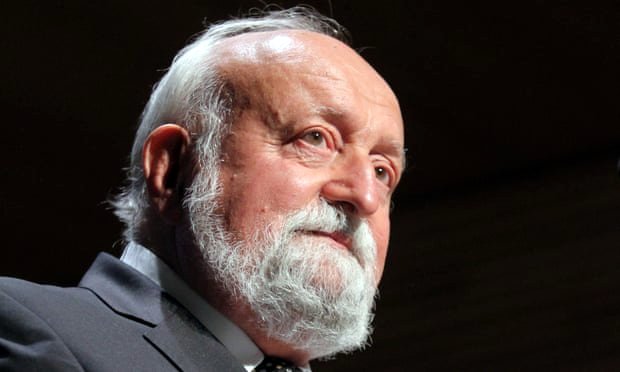 From Kubrick to Aphex Twin, Lynch to Radiohead, the Polish composer’s otherworldly sounds have inspired musicians and soundtracked some of cinema’s most haunting moments
From Kubrick to Aphex Twin, Lynch to Radiohead, the Polish composer’s otherworldly sounds have inspired musicians and soundtracked some of cinema’s most haunting moments
When I unearthed a score of Krzysztof Penderecki’s Symphony No 1 in my local library during my early teens, my idea of what music could be changed forever. I knew how conventional music sat on the page, but the score of Penderecki’s symphony looked like a byzantine scientific diagram had somehow got mangled in the photocopier with an Ordnance Survey map: disembodied staves, notes scattering everywhere, thick black lines sliding off the page. Once I managed to find a recording, it sounded great too – an utterly addictive playground of restless, relentlessly surprising noise.
Penderecki, whose death at the age of 86 was announced today, was born in Dębica, in south-east Poland in 1933. He emerged as a force in Polish modern composition alongside such figures as Witold Lutosławski, Tadeusz Baird, Andrzej Dobrowolski and Henryk Mikołaj Górecki who, during the late 1950s, were all constructing pieces using clusters of notes jam-packed together, often requiring players to explore terrain that pushed beyond the conventions of their instrument.
In 1960, the young composer wrote a piece for 52 string instruments that he called 8’37” (a nod towards John Cage’s 4’33”) in which sounds collided like swarms of bees; instruments were slapped and hit, and bows were employed to make violins et al squeak and squeal rather than sing. The piece made an immediate impression and when Penderecki, struck by the emotional turmoil of the apocalyptic sounds he had unleashed, retitled it Threnody to the Victims of Hiroshima, he found himself with an unexpected hit.
His First Symphony, which was completed in 1973, drew this period of sonic exploration to a close. By the time Penderecki started his Second Symphony in 1979, subtitled “Christmas”, he had re-engaged with a Romanticism that recalled Wagner, Bruckner, Mahler and Schumann, and obviously relished doing so; the symphony took its title from references to Silent Night that he had woven through the texture. Traditionally perspectives on Penderecki divide sharply at this point: admirers of the Threnody and First Symphony pour scorn on the Christmas Symphony and everything that followed in its wake, while those who like the Romantic version of Penderecki thank their lucky stars that he had moved on from the avant garde.
In reality, though, neither point of view really gets Penderecki right. Threnody – and similar works such as Fluorescences and De natura sonoris I – were undoubtedly impressive, but perhaps lacked the careful ear of Ligeti’s works using the orchestra as a sound mass, written during the same period. And if the project of latter-day Penderecki was about creating a sequence of symphonies, concertos and sacred works that could tap into that apparently unquenchable enthusiasm that audiences have for big Romantic statements like those made by the likes of Mahler and Shostakovich, those mass audiences never quite came.
The Christmas Symphony had its longueurs, but Penderecki was a very devotional man, and the St Luke Passion he completed in 1966 suggested that his focus could be sharpened by the constraints of text – as the devotional works that followed, Canticum Canticorum Salomonis, Polish Requiem and De Profundis, proved. Penderecki’s later instrumental music could feel oddly misjudged: a 2001 Piano Concerto, written in the aftermath of the September 11 terrorist attacks, was liberally sprinkled with jaunty bass lines and comedy “wrong” notes.
And yet Penderecki remained culturally important, a composer often considered a gateway into modern composition by those outside new music – his visceral, other-worldly sounds were eagerly repurposed by film-makers, and proved malleable and adaptable enough for musicians of other disciplines to work up into something new. His music was used in The Exorcist; by David Lynch in Wild at Heart, Inland Empire and in his recent reboot of Twin Peaks; and Penderecki was reportedly very displeased with how Stanley Kubrick had chopped up and looped sections of De natura sonoris II during the climactic scene of The Shining.
In 1991, the Manic Street Preachers opened their song You Love Us with a lengthy sample from Threnody to the Victims of Hiroshima, while Aphex Twin produced remixes of the Threnody and Polymorphia in 2011, working with the composer himself. Penderecki also formed an unlikely partnership with Radiohead’s Jonny Greenwood, which resulted in a collaborative album in 2012 and a whole new audience for a composer then about to turn 80. That year, Greenwood told the Guardian that he was attracted to Penderecki’s music because it spoke this universal truth: “Penderecki’s early music, and the whole thing of writing for orchestras, still feels very modern. If I think about music in the future, I imagine it often as not involving electricity, in some dystopian, postapocalyptic future. And that’s what I get from Penderecki: people making music by taking these instruments out of boxes and playing them. That’s a very bizarre and modern thing.”
Source: The Guardian
